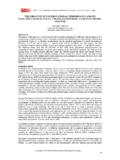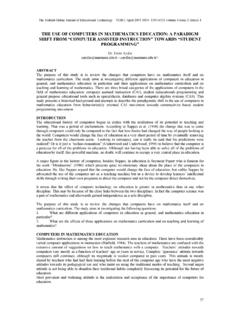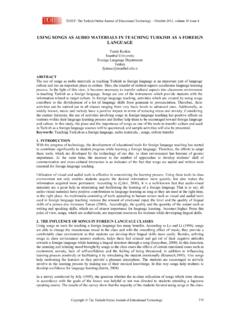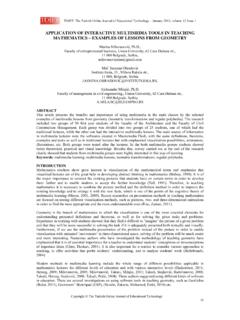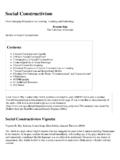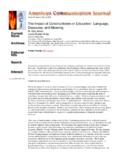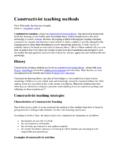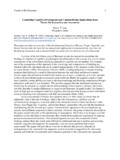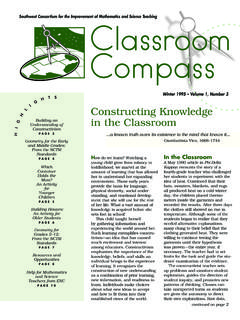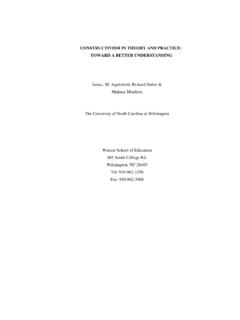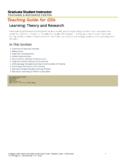Transcription of THE USE OF COMPUTER TECHNOLOGIES IN THE …
1 The Turkish Online Journal of Educational Technology TOJET April 2005 ISSN: 1303-6521 volume 4 Issue 2 Article 3 18 THE USE OF COMPUTER TECHNOLOGIES IN THE social STUDIES CLASSROOM Mehmet Acikalin PHD student at the Ohio State University-Columbus OH-USA social Studies & Global Education 668 Stinchcomb Dr. #6, Columbus OH 43202, Ph: 614 263-6918 Erdinc Duru Post-doctoral student at Penn State University, Harrisburg PA-USA. School of Behavioral Sciences and Education ABSTRACT Nowadays, the use of technology in education has become more popular. Special attention has been given to the adaptation of COMPUTER technology into teaching-learning process for effective learning and increasing students achievement. In recent years, it has been realized that there is an immense benefit in applying COMPUTER technology in the social studies classroom.
2 The first purpose of this study is to review COMPUTER - and Internet-supported instructional strategies in the social studies classroom. The second purpose of the study is to investigate the degree of application of these strategies in the social studies classroom. Thus, based on the literature review, the results of the research regarding COMPUTER technology in the social studies classroom are summarized, and educational implications are discussed. In addition, some suggestions for further research were offered. Key Words: COMPUTER , Technology, social Studies, Teaching and Learning, Effectiveness. SOSYAL ALANLAR SINIFLARINDA B LG SAYAR TEKNOLOJ LER KULLANIMI ZET G n m zde e itimde teknoloji kullan m pop ler olmu , etkili renme ve ba ar i in renme- retme s reci i erisine bilgisayar teknolojilerinin adaptasyonuna zel bir ilgi g sterilmi tir.
3 Ancak yak n y lllar i erisinde sosyal alanlar ile ilgili s n flarda bilgisayar teknolojisine ba vurman n b y k yarar oldu unun fark na var lm t r. Bu al man n birinci amac , sosyal bilimlerde bilgisayar ve internet destekli retme stratejileriyle ilgili alanyaz n taramakt r ve ikinci olarak bu stratejilerin sosyal alanlarla ilgili s n flarda uygulama d zeyini ara t rmakt r. Bu ama la, alanyaz na ba l olarak, sosyal alanlarda kullan lan bilgisayar teknolojisiyle ilgili ara t rma sonu lar zetlenmi , ara t rma sonu lar e itim s reciyle ili kileri er evesinde tart lm ve yak n al malar i in baz nerilerde bulunulmu tur. Anahtar Kelimeler: Bilgisayar, Teknoloji, Sosyal Alanlar, renme- retme, Etkililik. INTRODUCTION Technology use in education has become more popular in recent years.
4 There have been major developments in COMPUTER hardware and software in the last decades which increase the COMPUTER integration in education. The use of computers in education opens a new area of knowledge and offers a tool that has a potential to change some of traditional and ineffective educational methods (Asan, 2003). It is currently considered as crucial to modernize educational systems on the basis of information and communication TECHNOLOGIES (ICT), as globalization and transformation to the information society call for new literacy for the information society (UNESCO, 2002; as cited in Orhun, 2003, ). There is an increasing research on the effectiveness and benefits of the integration COMPUTER technology in education in recent years.
5 Sheffield (1996) stated that as a result of the recent developments in technology, computers and the Internet have become more important teaching tools in the social studies classroom. As Vanfossen (2001) points out, there are many supporters who claim that there are many benefits of Internet use in the classroom such as the ability to break down the classroom s physical limitations and expanding students experiences, development of students inquiry and analytical skills and expanding students experiences with visual TECHNOLOGIES . It is considered that technology is the main support for the students learning developments and the computers are the main technology support as a tool for effective learning and teaching process. (Isman The Turkish Online Journal of Educational Technology TOJET April 2005 ISSN: 1303-6521 volume 4 Issue 2 Article 3 19et al.)
6 , 2004; Usun, 2004). Likewise, Whitworth & Berson (2003) point out that, within the social studies, technology has served a dual role as an important instructional tool that may have a significant effect on the global, political, social , and economic functioning of society. According to them, as a method or topic instruction, computers and technology may have significant impacts on social studies education. There are a number of COMPUTER - and Internet-supported teaching strategies that are applied in the social studies classroom as well as other disciplines. According to the National Council for social Studies (1994), social studies is the integrated study of the social sciences such as anthropology, archaeology, economics, geography, history, law, philosophy, political science, psychology, religion, and sociology, as well as appropriate content from the humanities, mathematics, and natural sciences.
7 According to Berson (1996), the disciplines of social studies are indented to develop effective citizens who possess the critical thinking and decision making skills to function in a democratic society. Likewise, Tezci (2003) reported that the web based teaching do not only improve students academic skills, but also has positive effects on the development of democratic conscious of students. Thus, reflective inquiry, problem solving and decision making are considered as essential skills for the contemporary social studies education, which promotes effective citizenship in a democratic society (Berson, 1996; Rice & Wilson, 1999). Research showed that COMPUTER and the Internet supported teaching strategies have crucial roles facilitating development of students critical thinking, problem solving and decision making skills (Berson, 1996; Rice & Wilson, 1999; Adiguzel & Akpinar, 2001).
8 Thus, the first purpose of this paper is to review COMPUTER and Internet- supported teaching strategies in the social studies classroom. The second purpose is to investigate the degree of application of these strategies in the social studies classroom. DRILL AND PRACTICE, TUTORIALS, AND STUDY GUIDES One of the aspects of social studies education involves the learning of facts, important dates of history, geographic names and so forth. Therefore, drill-and-practice, tutorial, and study guides have been among the most frequently used programs in the social studies classroom (Rice & Wilson, 1999; Berson, 1996). One of the first national surveys in the United States about social studies teachers COMPUTER use indicated the significant use of drill and practice and tutorials among social studies teachers (Northup &Rooze, 1990).
9 The data which were collected from the randomly selected members of the National Council for social Studies showed that approximately 24% of social studies teachers listed these applications as main teaching strategies. In addition, the data indicated that drill and practice was the third common used strategy among the participants whereas tutorials ranked fifth (Northup & Rooze, 1990). Likewise, Pye and Sullivan (2001) in a study among middle school social studies teachers found that almost 22% of social studies teachers used drill and practice and tutorials in their classroom. Although the study indicated that other COMPUTER software and the Internet became more frequently used teaching tools in social studies as opposed to drill, practice, and tutorials, it seems that these applications are still important teaching tools for social studies teachers.
10 Although such COMPUTER applications are very appropriate to be used in the social studies classroom, there is not much research on the effectiveness of these applications. According to Ehman and Glenn (1991), tutorial, and drill and practice programs seemed to have positive impacts on student learning and attitude outcomes (p. 520). Similar results were reported by Higgins and Boone (as cited in Berson, 1996) and Roedding (as cited in Berson, 1996) who found small, but positive gains in secondary students' performance and attitudes toward the subject matter when COMPUTER drill-and-practice programs or hypermedia study guides were implemented. It seems that data on the effectiveness of drill-and-practice, tutorial, and study programs showed positive effects on students outcomes. According to Berson (1996), however, there is need for further research to address questions regarding the effects of these applications on the taxonomic level of students.
